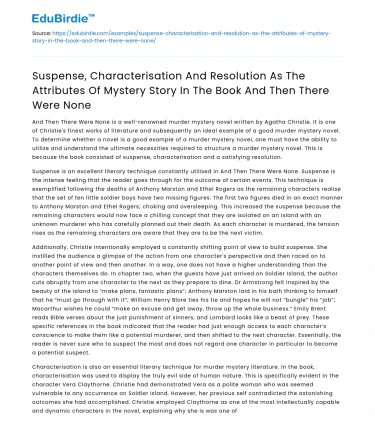And Then There Were None is a well-renowned murder mystery novel written by Agatha Christie. It is one of Christie's finest works of literature and subsequently an ideal example of a good murder mystery novel. To determine whether a novel is a good example of a murder mystery novel, one must have the ability to utilize and understand the ultimate necessities required to structure a murder mystery novel. This is because the book consisted of suspense, characterisation and a satisfying resolution.
Suspense is an excellent literary technique constantly utilised in And Then There Were None. Suspense is the intense feeling that the reader goes through for the outcome of certain events. This technique is exemplified following the deaths of Anthony Marston and Ethel Rogers as the remaining characters realise that the set of ten little soldier boys have two missing figures. The first two figures died in an exact manner to Anthony Marston and Ethel Rogers; choking and oversleeping. This increased the suspense because the remaining characters would now face a chilling concept that they are isolated on an island with an unknown murderer who has carefully planned out their death. As each character is murdered, the tension rises as the remaining characters are aware that they are to be the next victim.
Additionally, Christie intentionally employed a constantly shifting point of view to build suspense. She instilled the audience a glimpse of the action from one character's perspective and then raced on to another point of view and then another. In a way, one does not have a higher understanding than the characters themselves do. In chapter two, when the guests have just arrived on Soldier Island, the author cuts abruptly from one character to the next as they prepare to dine. Dr Armstrong felt inspired by the beauty of the island to “make plans, fantastic plans”; Anthony Marston laid in his bath thinking to himself that he “must go through with it”; William Henry Blore ties his tie and hopes he will not “bungle” his “job”; Macarthur wishes he could “make an excuse and get away, throw up the whole business.” Emily Brent reads Bible verses about the just punishment of sinners, and Lombard looks like a beast of prey. These specific references in the book indicated that the reader had just enough access to each character’s conscience to make them like a potential murderer, and then shifted to the next character. Essentially, the reader is never sure who to suspect the most and does not regard one character in particular to become a potential suspect.
Characterisation is also an essential literary technique for murder mystery literature. In the book, characterisation was used to display the truly evil side of human nature. This is specifically evident in the character Vera Claythorne. Christie had demonstrated Vera as a polite woman who was seemed vulnerable to any occurrence on Soldier Island. However, her previous self contradicted the astonishing outcomes she had accomplished. Christie employed Claythorne as one of the most intellectually capable and dynamic characters in the novel, explaining why she is was one of the last people left standing. She outwitted Philip Lombard, who thought she was a murderer, by stealing his gun and then summoning up the courage to shoot him when he leaps at her. Radically, Claythorne transformed throughout the course of the novel due to drastic influence from life-threatening situations surrounding her. However, Claythorne’s guilt, tendency toward hysteria, and her appeal with the nursery rhyme “Ten Little Soldier Boys” allowed Wargrave (the murderer) to inspire Vera to hang herself and subsequently fulfil the last line of the poem; “one little Soldier boy left all alone; he went out and hanged himself and then there were none.”
A satisfying epilogue is mandatory in all murder mystery novels. To determine whether an epilogue in a murder mystery novel is satisfying or not, it requires to reveal the truths about the characters falsely suspected. This is demonstrated when Lawrence Wargrave stated that “I wanted to kill… Yes, I wanted to kill.” (p. 288). This quote revealed that the murderer was Wargrave and that he had the ambition to kill. This quote is so beneficial to the overall novel, as the reader can fundamentally get in the mind of the character and trace the character footprints, and consequently understand the text to a fuller potential. In a way, Christie had intentionally employed Wargrave as the least likely figure to be the murderer as he was the least suspected to have committed anything negative with the law. This is because his past suggested that he was a judge, which is a primary figure to have nothing negative in relation to law. Christie had possibly implemented Wargrave as the murderer to employ a sense of irony.
Fundamentally, it depends on one's perspective to determine whether or whether not a novel can be determined as a good murder mystery or not. However, judging by the constant use of suspense, the beneficial utilisation of characterisation and the pleasurable resolution And Then There Were None can be concluded as a good example of a murder mystery. These are all compulsory elements in murder mystery literature as without the usage of suspense characterisation and the pleasurable resolution the novel would be dull, tiresome and subsequently, give no reason for the reader to keep reading the book.






 Stuck on your essay?
Stuck on your essay?

